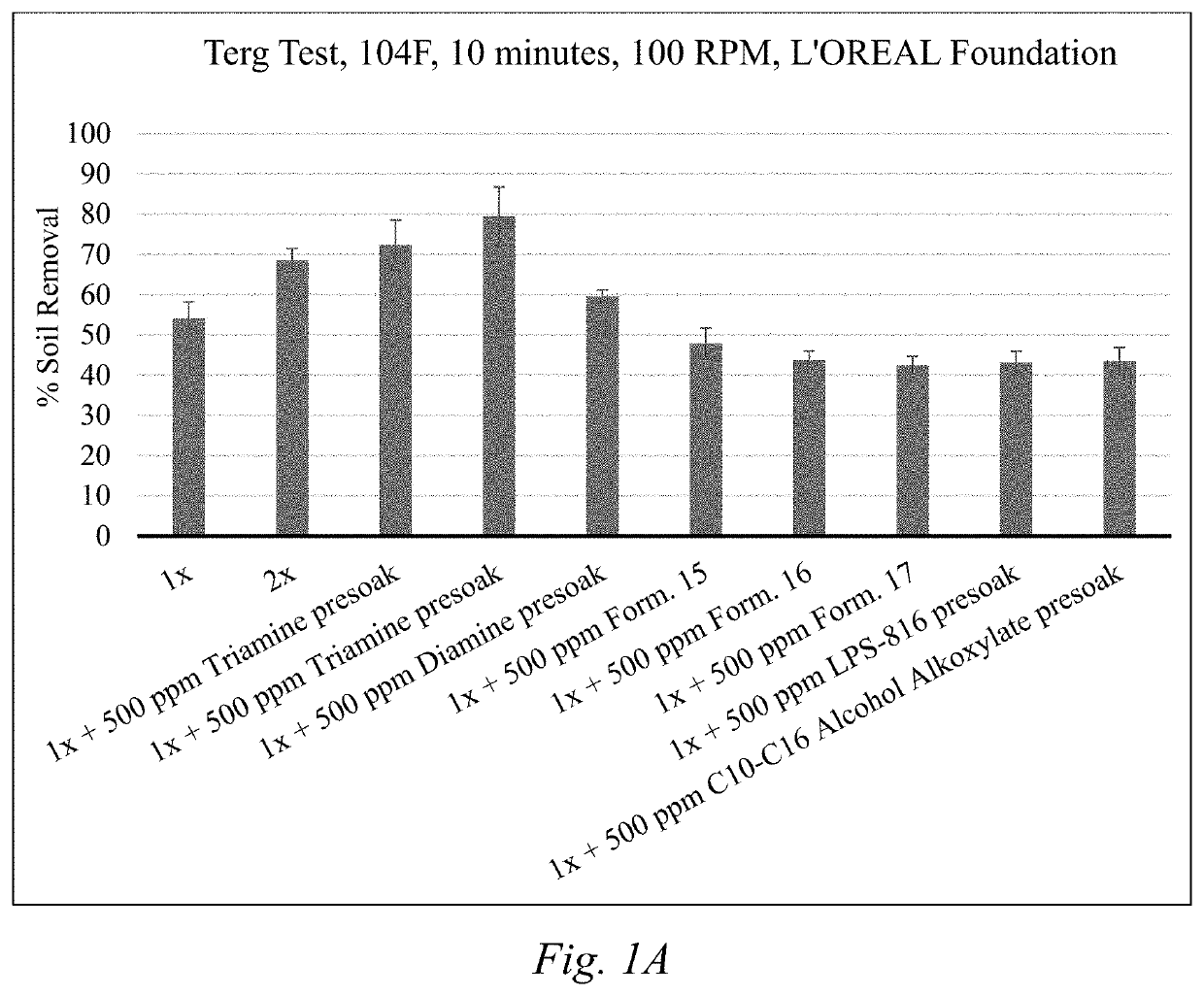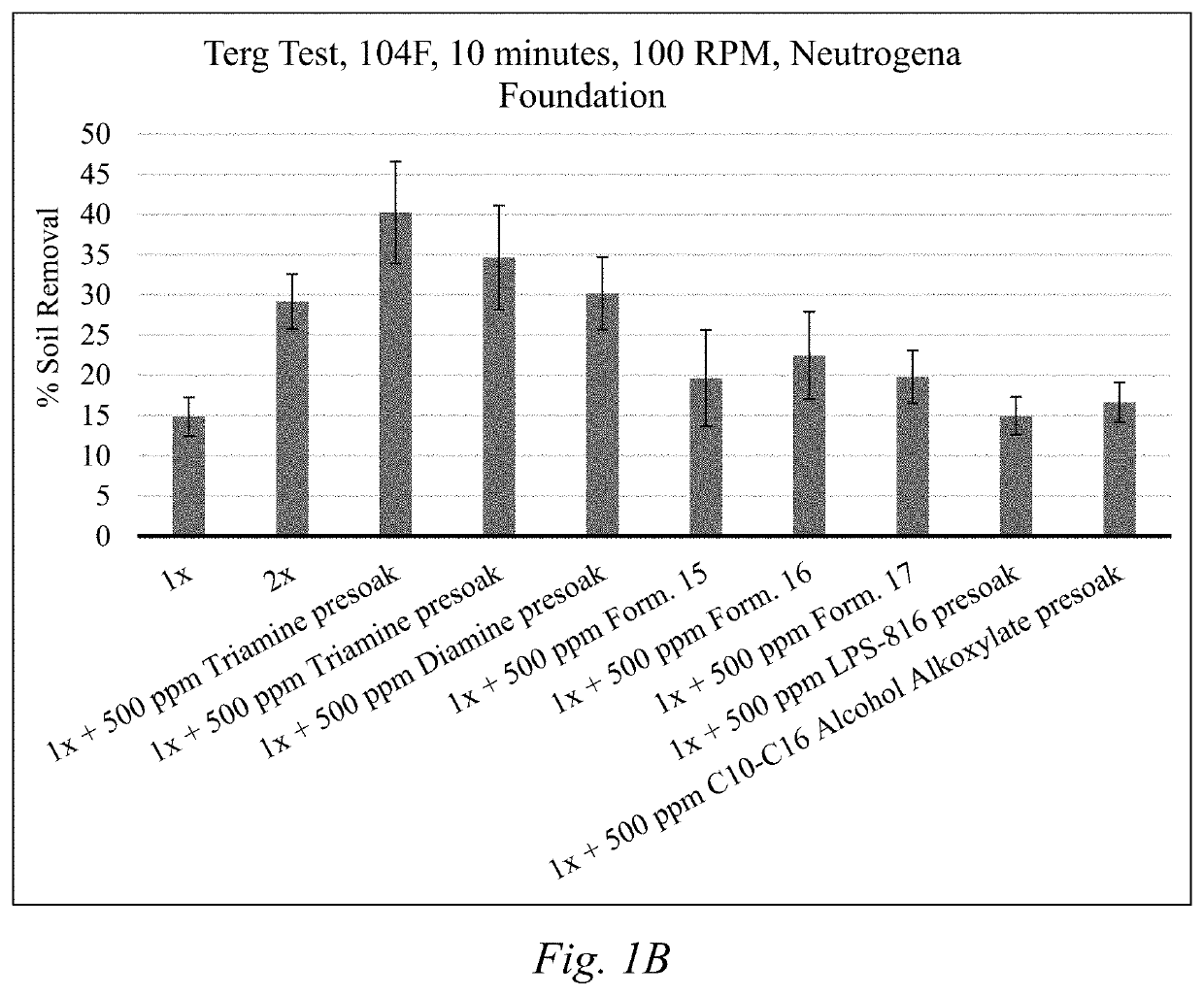Soil removal on cotton via treatment in the rinse step for enhanced cleaning in the subsequent wash
- Summary
- Abstract
- Description
- Claims
- Application Information
AI Technical Summary
Benefits of technology
Problems solved by technology
Method used
Image
Examples
example 1
ce Assessment of Non-Quaternary Amine Compositions
[0331]A performance assessment of the compositions was conducted to determine the effects of different presoaking surfactant packages' ability to help remove soil from a variety of textiles. Textiles evaluated included percale, weave, and terry cotton.
[0332]Use solutions were prepared with 500 ppm of example cationic amine compounds using at least one amine and at least one surfactant disclosed accordingly:
ComponentTypeAmine(s)TriamineN,N-Bis (3-aminopropyl) dodecylamineDiamineN1,N1,N3-tris(3-aminopropyl)-N3-dodecylpropane-1,3-diamine; N1,N1-bis(3-aminopropyl)-N3-dodecylpropane-1,3-diamine;N1-(3-aminopropyl)-N3-dodecylpropane-1,3-diamine; N-dodecylpropane-1,3-diamineEtherN′[3-(11-methyldodecoxy)propyl]propane-1,3-DiaminediamineSurfac-NonionicFatty alcohol polyglycol ethertant(s)SurfactantCationic(Coconut oil alkyl)bis(2-hydroxyethyl,Quaternaryethoxylated)methylammoniumAmmoniumChlorideCompoundSemi-PolarDimethyl tetradecyl Amine oxideN...
example 2
lity Assessment of Non-Quaternary Amine Compositions and Traditional Softeners
[0336]The example finishing compositions were also tested for compatibility with traditional softeners to evaluate the potential use of co-softeners in the formulation. For this, swatches were again treated with a 500-ppm use solution of an example finishing compound including both a cationic amine compound and a traditional softener compound as a co-softener. The procedures from Example 1 were followed with treating, drying, soiling, washing, and the tergotometer test. For this test, the swatches were soiled with an example lipstick, waterproof mascara, or foundation. The results are provided in FIGS. 2A-2C. FIG. 2A provides the results for swatches soiled with Maybelline waterproof mascara. FIG. 2B provides the results for swatches soiled with Covergirl lipstick. FIG. 2C provides the results for swatches soiled with Neutrogena foundation.
[0337]As can be seen in FIGS. 2A-2C, the example cationic amine com...
example 3
ce Assessment of Silicone Soil Release Agent and Surfactant Package
[0338]Example compositions were prepared according to Table 4 below. Clean cotton terry swatches were soaked in use solutions of these compositions at varying concentrations of between 50 ppm to 100 ppm of each of the silicone or surfactant to emulate the finishing step of a wash cycle. The swatches were then soiled with Covergirl lipstick. The soiled swatches were left to set overnight under ambient conditions. The swatches were then washed with 500 ppm of the liquid detergent according to Table 3 along with 600 ppm builder. These swatches were compared to soiled swatches washed with 1× (500 ppm detergent and 600 ppm builder) and 2× (1000 ppm detergent and 1200 ppm builder) according to Table 3. Tergotometer testing was performed on the swatches according to the procedure outlined in Example 1.
TABLE 4Exp.Exp.Exp.Exp.F. 1F. 2F. 3F. 4Material(wt. %)(wt. %)(wt. %)(wt. %)Silicone16152019Dodecyl dimethyl amine oxide85Met...
PUM
 Login to View More
Login to View More Abstract
Description
Claims
Application Information
 Login to View More
Login to View More - R&D
- Intellectual Property
- Life Sciences
- Materials
- Tech Scout
- Unparalleled Data Quality
- Higher Quality Content
- 60% Fewer Hallucinations
Browse by: Latest US Patents, China's latest patents, Technical Efficacy Thesaurus, Application Domain, Technology Topic, Popular Technical Reports.
© 2025 PatSnap. All rights reserved.Legal|Privacy policy|Modern Slavery Act Transparency Statement|Sitemap|About US| Contact US: help@patsnap.com



